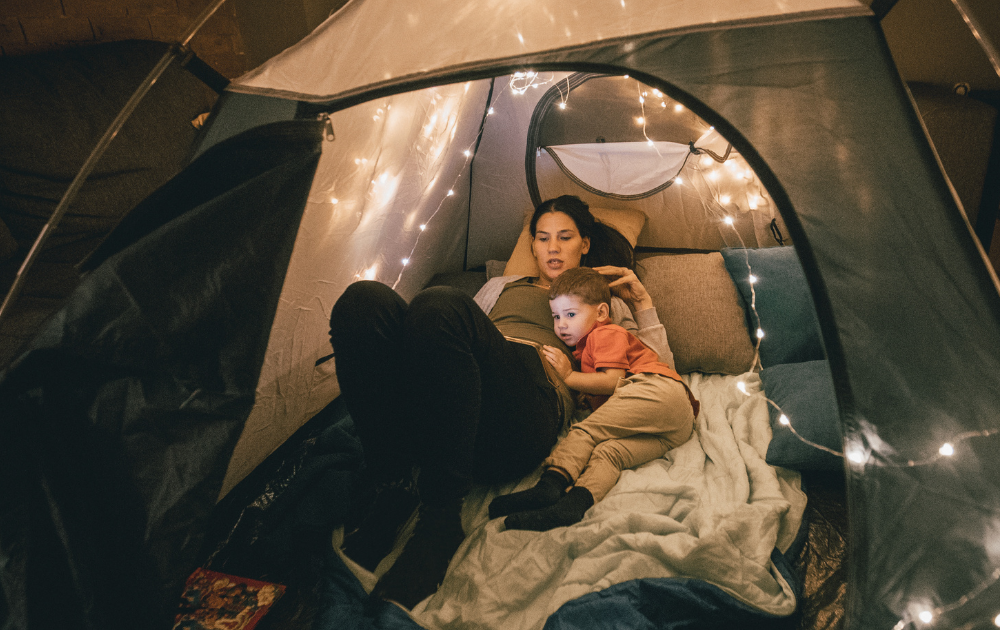
14 Sep Encouraging Children To Read: How To Foster A Love Of Books At Every Age
Is there anything better than curling up on a Sunday afternoon with a cup of tea and a good book? Losing yourself in a fantasy novel or catching up with your favorite fiction writer is a great first step for fostering a love of books and reading in your child. Children do what they see far more than what they are told – experts in child psychology all agree on that. And when they see you reading, when they see you devouring and delighting in book after book, they will begin to develop a curiosity about what lies between the covers. If you consistently set that example, demonstrating that worlds of knowledge and narratives are found in books, they will want to join you on that journey of learning.
How else can you foster a love of reading? We have a few suggestions for you on that score!
1. Bedtime stories become a lifelong love of books.

Reading to your child at bedtime, even before they may be old enough to fully understand all the words, sentences and plot twists, is how you instill an initial love of books. Whether it’s the Harry Potter series, Winnie the Pooh or another classic, reading at night accomplishes several things: you and your child bond over books. They relax after a busy day at school or engage in other activities and fall easily to sleep. And you fire up their imagination by talking about the book’s plot and characters. You can even make the story relevant to their life at home or at school. For example, let’s say you’re reading a book about a little girl’s love of dancing. You can ask your child how they feel about the activity, if their friends love to dance, and other aspects that bring the fictional world into their own, real one.
2. Take books beyond bedtime

Ensuring your child has access to books all the time is another important ingredient to developing their love of reading. You don’t, necessarily, have to build a library in your home, but be sure they have a library card! Take them once a week to an event at the library that revolves around books – perhaps a speaking engagement by a local children’s book author. These things all add to your child’s familiarity with books, and that means they will develop a comfort level with, and a curiosity about, books in all genres, particularly as they grow older.
3. Read the book and then watch the movie.
If one positive thing can be said about all the sequels and remakes Hollywood puts out in the children’s movie category, it’s that many of them are based on books – Harry Potter is just one example. Before heading to the movie theater, get the novel out of the library or head out to the bookstore one afternoon and buy it.
Read it together, then go see the film. Ask your child their opinions on everything from the cast of characters to plot devices. It may surprise you to learn that studies show that, when quizzed, a majority of children who first read the book before seeing the film say the book was better! Just like adults, they recognize how much more fully developed a written, fictional world can be, and that screen adaptations are sometimes lacking.
4. Don’t tie reading to rewards.

If your child isn’t reading as often or at the level, you would like, it’s risky to reward them for doing more. After all, reading is its own reward, right? Saying they can have ice cream for dessert or watch a favorite TV show if they’ll just finish another chapter makes reading seem like a chore. Avoid that trap; instead, read with them until you’re sure it isn’t just that they are bored by the material, or something else that’s easily remedied. You might find they are bored because their reading skills are past the book they’re currently engaged with. Or it might be something else you need to be aware of, like a learning disability.
5. Make sure there is not a problem.

If you see your child struggle with the lines on a page, or consistently fail to pronounce words that should come easily at their age, you might want to have their skill level assessed by a professional. All children learn differently and at different paces, so most of the time there is no cause for concern. But it’s vital that a learning disability like dyslexia not go undiagnosed or untreated – the sooner it’s recognized, the better.
6. Give them books as presents for birthdays and holidays.

Giving children books for Christmas and on other occasions sends the message that reading is something to be cherished and looked forward to. Giving them a steady supply of new books communicates that. Consider introducing them to a series by an author you (and they) admire. Keep the books appropriate to their age, but don’t be afraid to challenge them a little, particularly if they become avid readers and you sense that the books they have don’t engage them sufficiently.
7. Don’t limit them to online research.
Naturally your child should grow up digitally literate, but Googling something to learn about it is not the only – or most reliable – route for acquiring knowledge. A set of encyclopedias is not expensive and gives children another avenue for acquiring information. Learning accurate facts happens when children reach out to more than one source, and that includes books.
8. Create a cozy spot for reading.

If there is a quiet spot your child can retreat to in order to enjoy a new book, that makes for a more enjoyable experience. Reading takes concentration, so a comfortable chair in a quiet room means they can focus on the material at hand.
Reading is something parents should introduce to children as soon as they’re able to enjoy storytelling – in other words, almost from the moment they’re born.
They need not be able to hold a book or read full sentences to find joy in powerful narratives. When children are raised in an environment that promotes, supports and thrives on reading of all kinds, everything from “kid lit” to YA (young adult) fiction to hardcover novels and nonfiction, it becomes a way for them to gain more than knowledge. They find comfort and joy in reading too, because books open the world to them, and engage them with other people, other places, and other cultures, too.